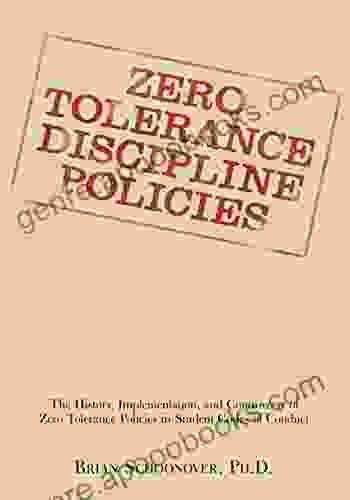The History, Implementation, and Controversy of Zero Tolerance Policies in American Schools

Zero tolerance policies are a set of school discipline policies that mandate harsh and automatic punishments for even minor infractions. These policies were first implemented in the United States in the 1990s, in response to a perceived increase in school violence. However, zero tolerance policies have been criticized for their harsh and often unfair consequences, particularly for students of color and students with disabilities.
The first zero tolerance policy was implemented in the United States in 1994, in the wake of several high-profile school shootings. The policy, known as the Gun-Free Schools Act, mandated that any student who brought a gun to school would be expelled for at least one year.
In the years that followed, many other schools adopted zero tolerance policies, not only for weapons offenses, but also for a wide range of other behaviors, such as fighting, drug possession, and even talking back to a teacher. By the early 2000s, zero tolerance policies were in place in over 90% of American schools.
5 out of 5
| Language | : | English |
| File size | : | 229 KB |
| Text-to-Speech | : | Enabled |
| Enhanced typesetting | : | Enabled |
| Word Wise | : | Enabled |
| Print length | : | 100 pages |
| Paperback | : | 96 pages |
| Item Weight | : | 5.6 ounces |
| Dimensions | : | 5.4 x 0.4 x 8.5 inches |
| Screen Reader | : | Supported |
Zero tolerance policies are typically implemented through a school's code of conduct. The code of conduct outlines the specific behaviors that are prohibited, and the consequences for violating those rules.
Zero tolerance policies typically mandate harsh punishments for even minor infractions. For example, a student who brings a toy gun to school may be expelled, even if they did not intend to harm anyone. A student who talks back to a teacher may be suspended, even if they were simply expressing their opinion.
Zero tolerance policies have been shown to have a number of negative consequences, particularly for students of color and students with disabilities.
- Students of color are disproportionately impacted by zero tolerance policies. Black students are three times more likely to be suspended or expelled than white students, even though they commit the same or fewer offenses. This disparity is likely due to the fact that Black students are more likely to be perceived as threatening by school staff.
- Students with disabilities are also disproportionately impacted by zero tolerance policies. Students with disabilities are more likely to be suspended or expelled for behaviors that are related to their disabilities. For example, a student with ADHD may be suspended for fidgeting or talking out of turn.
- Zero tolerance policies can lead to the school-to-prison pipeline. The school-to-prison pipeline is a term used to describe the trend of students being pushed out of school and into the juvenile justice system. Zero tolerance policies contribute to the school-to-prison pipeline by suspending and expelling students for minor offenses.
Zero tolerance policies have been the subject of much controversy. Critics argue that these policies are too harsh and that they unfairly target students of color and students with disabilities. Critics also argue that zero tolerance policies do not actually make schools safer.
Supporters of zero tolerance policies argue that these policies are necessary to deter crime and violence in schools. They also argue that zero tolerance policies are fair and that they apply to all students equally.
Zero tolerance policies are a controversial set of school discipline policies that have been shown to have a number of negative consequences, particularly for students of color and students with disabilities. There is no evidence that zero tolerance policies actually make schools safer. In fact, these policies may actually contribute to the school-to-prison pipeline.
It is time for schools to rethink their approach to discipline. Instead of relying on harsh and automatic punishments, schools should focus on restorative practices that aim to resolve conflicts and repair relationships.
5 out of 5
| Language | : | English |
| File size | : | 229 KB |
| Text-to-Speech | : | Enabled |
| Enhanced typesetting | : | Enabled |
| Word Wise | : | Enabled |
| Print length | : | 100 pages |
| Paperback | : | 96 pages |
| Item Weight | : | 5.6 ounces |
| Dimensions | : | 5.4 x 0.4 x 8.5 inches |
| Screen Reader | : | Supported |
Do you want to contribute by writing guest posts on this blog?
Please contact us and send us a resume of previous articles that you have written.
 Book
Book Novel
Novel Page
Page Chapter
Chapter Text
Text Story
Story Genre
Genre Reader
Reader Library
Library Paperback
Paperback E-book
E-book Magazine
Magazine Newspaper
Newspaper Paragraph
Paragraph Sentence
Sentence Bookmark
Bookmark Shelf
Shelf Glossary
Glossary Bibliography
Bibliography Foreword
Foreword Preface
Preface Synopsis
Synopsis Annotation
Annotation Footnote
Footnote Manuscript
Manuscript Scroll
Scroll Codex
Codex Tome
Tome Bestseller
Bestseller Classics
Classics Library card
Library card Narrative
Narrative Biography
Biography Autobiography
Autobiography Memoir
Memoir Reference
Reference Encyclopedia
Encyclopedia Robert Fetner
Robert Fetner Pamela Warren
Pamela Warren Marjorie J Spruill
Marjorie J Spruill Vanessa Mccausland
Vanessa Mccausland Travis Shreffler
Travis Shreffler Mandy Concepcion
Mandy Concepcion Kimberly Knight
Kimberly Knight Ward Serrill
Ward Serrill Michael Allaby
Michael Allaby Michael M Crow
Michael M Crow Tom Duke
Tom Duke Mazen M Sinjab
Mazen M Sinjab Mike Socarras
Mike Socarras Pamela Chanko
Pamela Chanko Marilyn Migiel
Marilyn Migiel Rachel Oates
Rachel Oates Mark Winegardner
Mark Winegardner Nicole Burton
Nicole Burton Pieter Louis Myburgh
Pieter Louis Myburgh Sharon E Cathcart
Sharon E Cathcart
Light bulbAdvertise smarter! Our strategic ad space ensures maximum exposure. Reserve your spot today!

 Xavier BellFavorite Disney Songs for Cello Instrumental Play Along: Unlock the Magic of...
Xavier BellFavorite Disney Songs for Cello Instrumental Play Along: Unlock the Magic of... Edmund HayesFollow ·17k
Edmund HayesFollow ·17k Isaiah PowellFollow ·10.7k
Isaiah PowellFollow ·10.7k Joseph ConradFollow ·11.6k
Joseph ConradFollow ·11.6k Allen ParkerFollow ·13.5k
Allen ParkerFollow ·13.5k Eliot FosterFollow ·4.1k
Eliot FosterFollow ·4.1k Drew BellFollow ·2.4k
Drew BellFollow ·2.4k Bob CooperFollow ·19.1k
Bob CooperFollow ·19.1k Isaiah PriceFollow ·17.7k
Isaiah PriceFollow ·17.7k

 Finn Cox
Finn CoxCarmen Suite For Flute Quartet (G Alto Flute) ( Carmen...
Experience the Magic of...

 Andy Cole
Andy ColeUncover Hidden Truths: A Comprehensive Guide to Detecting...
: The Silent...

 Ken Simmons
Ken SimmonsUnleash Your Potential: Transform Frustration and...
Are you tired of feeling...

 Rick Nelson
Rick NelsonHard To Kill: A Gripping Thriller That Will Keep You on...
Tom Rollins is a...

 Ivan Turner
Ivan TurnerUnleash the Power of Your Breath: Discover Breath...
In the tapestry of life, where stress and...
5 out of 5
| Language | : | English |
| File size | : | 229 KB |
| Text-to-Speech | : | Enabled |
| Enhanced typesetting | : | Enabled |
| Word Wise | : | Enabled |
| Print length | : | 100 pages |
| Paperback | : | 96 pages |
| Item Weight | : | 5.6 ounces |
| Dimensions | : | 5.4 x 0.4 x 8.5 inches |
| Screen Reader | : | Supported |











